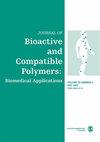Bioactivity of chitosan nanoparticles synthesized by a novel route towards Escherichia coli and Bacillus subtilis
IF 2.2
4区 生物学
Q3 BIOTECHNOLOGY & APPLIED MICROBIOLOGY
引用次数: 0
Abstract
Chitosan nanoparticles (CSNP) with an average size of 25.67 nm were synthesized via a novel wet chemical route and characterized using scanning electron microscopy (SEM) and Fourier Transform Infrared (FTIR) spectroscopy. Comparative antibacterial assays of Chitosan NP suspensions prepared in water (at neutral pH) and in dilute acetic acid and chitosan gel prepared in dilute acetic acid/hydrochloric acid (all at concentrations up to 1%) were performed against Escherichia coli ( E. coli) and Bacillus subtilis ( B. subtilis) bacteria using spread plate method. A parallel viability test was conducted to confirm the presence of surviving cells in the bulk test volume. Minimum bactericidal concentration (MBC) of chitosan gel was 0.5 mg/ml for the bulk chitosan dissolved in 0.05% v/v aq. acetic acid and 0.1 mg/ml for chitosan dissolved in 0.01% v/v aqueous (aq.) hydrochloric acid. In comparison, Chitosan NP were found to be growth promoter at neutral pH and exhibited cell protective efficacy in presence of aq. acetic acid. The biocidal activity of chitosan gel in acidic media was higher when prepared in strong inorganic acid, that is, aq. HCl in comparison with the gel prepared in a relatively weak organic acid that is, aq. CH以新型方法合成的壳聚糖纳米粒子对大肠杆菌和枯草杆菌的生物活性
通过新型湿化学方法合成了平均粒径为 25.67 纳米的壳聚糖纳米粒子(CSNP),并利用扫描电子显微镜(SEM)和傅立叶变换红外光谱(FTIR)对其进行了表征。采用涂布平板法,对在水中(中性 pH 值)和稀醋酸中制备的壳聚糖 NP 悬浮液以及在稀醋酸/盐酸中制备的壳聚糖凝胶(浓度均不超过 1%)进行了抗大肠杆菌和枯草杆菌的比较抗菌试验。同时还进行了存活率测试,以确认大量测试体积中是否存在存活的细胞。溶于 0.05% v/v 醋酸的壳聚糖凝胶的最小杀菌浓度(MBC)为 0.5 mg/ml,溶于 0.01% v/v 盐酸水溶液的壳聚糖凝胶的最小杀菌浓度(MBC)为 0.1 mg/ml。相比之下,壳聚糖 NP 在中性 pH 值下具有促进生长的作用,而在醋酸存在下则表现出细胞保护功效。在强无机酸(即盐酸)中制备的壳聚糖凝胶与在相对较弱的有机酸(即 CH3COOH)中制备的凝胶相比,在酸性介质中的杀菌活性更高。CH3COOH。抗菌作用也与 pH 值有关,pH 值较低时活性较高。不过,各种酸也具有类似的杀菌作用;这表明壳聚糖可能并不具有任何固有的抗菌特性,而基本上起着促进生长的作用。
本文章由计算机程序翻译,如有差异,请以英文原文为准。
求助全文
约1分钟内获得全文
求助全文
来源期刊

Journal of Bioactive and Compatible Polymers
工程技术-材料科学:生物材料
CiteScore
3.50
自引率
0.00%
发文量
27
审稿时长
2 months
期刊介绍:
The use and importance of biomedical polymers, especially in pharmacology, is growing rapidly. The Journal of Bioactive and Compatible Polymers is a fully peer-reviewed scholarly journal that provides biomedical polymer scientists and researchers with new information on important advances in this field. Examples of specific areas of interest to the journal include: polymeric drugs and drug design; polymeric functionalization and structures related to biological activity or compatibility; natural polymer modification to achieve specific biological activity or compatibility; enzyme modelling by polymers; membranes for biological use; liposome stabilization and cell modeling. This journal is a member of the Committee on Publication Ethics (COPE).
 求助内容:
求助内容: 应助结果提醒方式:
应助结果提醒方式:


